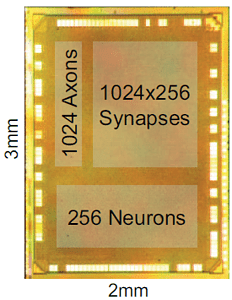First initiated in 2008 by IBM, the Systems of Neuromorphic Adaptive Plastic Scalable Electronics (SyNAPSE) program whose final goal is that of developing a new cognitive computer architecture based on the human brain. Recently, IBM announced it has reached an important milestone for its program after the company successfully simulated 10 billion neurons and 100 trillion synapses on most powerful supercomputer.
It’s worth noting, however, before you get too exited, that the IBM researchers have not t built a biologically realistic simulation of the complete human brain – this is still a goal that is still many years away. Instead, the scientists devised a cognitive computing architecture called TrueNorth with 1010 neurons (10 billion) and 1014 synapses (100 trillion) that is inspired by the number of synapses in the human brain; meaning it’s modular, scalable, non-von Neumann, ultra-low power. The researchers hope that in the future this essential step might allow them to build an electronic neuromorphic machine technology that scales to biological level.
“Computation (‘neurons’), memory (‘synapses’), and communication (‘axons,’ ‘dendrites’) are mathematically abstracted away from biological detail toward engineering goals of maximizing function (utility, applications) and minimizing cost (power, area, delay) and design complexity of hardware implementation,” reads the abstract for the Supercomputing 2012 (SC12) paper (full paper link).
Steps towards mimicking the full-power of the human brain

Authors of the IBM paper(Left to Right) Theodore M. Wong, Pallab Datta, Steven K. Esser, Robert Preissl, Myron D. Flickner, Rathinakumar Appuswamy, William P. Risk, Horst D. Simon, Emmett McQuinn, Dharmendra S. Modha (Photo Credit: Hita Bambhania-Modha)
IBM simulated the TrueNorth system running on the world’s fastest operating supercomputer, the Lawrence Livermore National Lab (LBNL) Blue Gene/Q Sequoia, using 96 racks (1,572,864 processor cores, 1.5 PB memory, 98,304 MPI processes, and 6,291,456 threads).
IBM and LBNL achieved an unprecedented scale of 2.084 billion neurosynaptic cores containing 53×1010 (530 billion) neurons and 1.37×1014 (100 trillion) synapses running only 1542 times slower than real time.
“Previously, we have demonstrated a neurosynaptic core and some of its applications,” continues the abstract. “We have also compiled the largest long-distance wiring diagram of the monkey brain. Now, imagine a network with over 2 billion of these neurosynaptic cores that are divided into 77 brain-inspired regions with probabilistic intra-region (“gray matter”) connectivity and monkey-brain-inspired inter-region (“white matter”) connectivity.
“This fulfills a core vision of the DARPA SyNAPSE project to bring together nanotechnology, neuroscience, and supercomputing to lay the foundation of a novel cognitive computing architecture that complements today’s von Neumann machines.”
According to Dr. Dharmendra S. Modha, IBM’s cognitive computing manager, his team goal is that of mimic processes of the human brain. While IBM competitors focus on computing systems that mimic the left part of the brain, processing information sequentially, Modha is working on replicating functions from the right part of the human brain, where information can be processed in parallel and where incredibly complex brain functions lie. To this end, the researchers combine neuroscience and supercomputing to reach their goals.
Imagine that the room-sized, cutting-edge, billion dollar technology used by IBM to scratch the surface of artificial human cognition still doesn’t come near our brain’s capabilities, which only occupies a fixed volume comparable to a 2L bottle of water and needs less power than a light bulb to work. The video below features Dr. Modha explaining his project in easy to understand manner and its only 5 minutes long.
source: KurzweilAI










